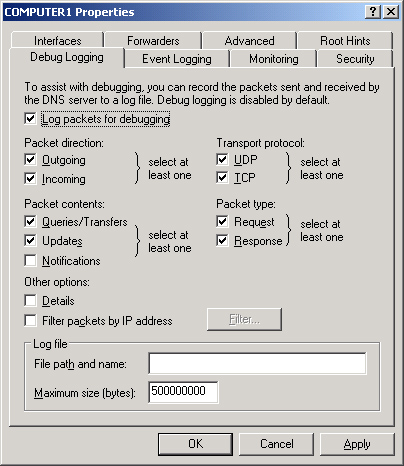DNS Debug Log
In addition to the DNS Events log, the DNS Server
service also maintains a separate log used for debugging. This DNS
debug log is a file named Dns.log that is stored in the
WINDOWS\System32\Dns\ folder. Because the Dns.log file is actively used
by the DNS Server service, you can view this file only after the DNS
Server service has been stopped. In addition, because the native format
of the Dns.log file is Rich Text Format (RTF), you should use WordPad to
view all of its contents properly.
By default, the DNS
debug log contains only DNS errors. However, you can also use it to
capture all DNS packets sent or received by the local DNS server. To
enable DNS packet logging, open the DNS server properties dialog box and
click the Debug Logging tab. By default, the Log Packets For Debugging
check box is cleared and the rest of the tab is unavailable.
However, after you
have selected the Log Packets For Debugging check box, as shown in Figure 6, you can configure which DNS packets you want
captured to the DNS log.

Using the Debug Logging
tab, you can configure the DNS log file to record the following types of
events:
Queries
Notification
messages from other servers
Dynamic
updates
Content
of the question section for DNS query messages
Content of the answer section for DNS query messages
Number of queries this server sends
Number
of queries this server has received
Number of DNS requests received over a User
Datagram Protocol (UDP) port
Number of DNS requests received over a Transmission
Control Protocol (TCP) port
Number of full packets sent by the server
Number of packets written
through by the server and back to the zone